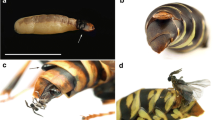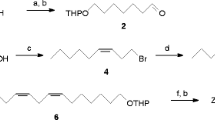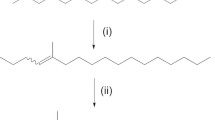Abstract
Three candidate sex pheromone components, (Z)6,(Z)9-, (Z)6,(E)8-, and (Z)6,(E)9-heneicosadien-11-one (Z6Z9, Z6E8, and Z6E9) were identified in pheromone gland extracts of female Douglas-fir tussock moths (DFTM), Orgyia pseudotsugata (McDunnough). Their occurrence in subnanogram quantities in extracts and structural conversion during analytical procedures and bioassays complicated chemical identifications. Complete identification required comparative analyses of stereoselectively synthesized and female-produced dienones by coupled gas chromatographic–electroantennographic detection (GC-EAD), high-performance liquid chromatography (HPLC) and coupled GC–mass spectrometry (MS). Determination of the pheromone component was contingent upon an experimental design that minimized structural rearrangement of dienones before and during the field test. In a 40-min field experiment, acetonitrile solutions of each of the above dienones were carried on Dry Ice to traps and were syringed onto cotton release devices below trap lids. In combination with the previously known sex pheromone component of DFTM, (Z)6-heneicosen-11-one (Z6), Z6E8 was the only synergistic dienone and the mixture was highly attractive. Because Z6 by itself attracts seven species of tussock moths (two sympatric with DFTM), a blend of Z6 and Z6E8 may impart specificity to DFTM pheromone communication. In commercial lures, this binary blend may facilitate species-specific, sensitive monitoring and efficacious control by mating disruption of this important forest defoliator.
Similar content being viewed by others
REFERENCES
ARN, H., STÄDLER, E., and RAUSCHER, S. 1975. The electroantennographic detector-A selective and sensitive tool in the gas chromatographic analysis of insect pheromones. Z. Naturforsch. 30c:722–725.
ARN, H., TÓTH, M., and PRIESNER E. 1992. List of sex pheromones of Lepidoptera and related attractants, 2nd ed. International Organization for Biological Control, Monfavet.
BUSER, H. R., GUERIN, P. M., TÓTH, M., SZÖCS, G., SCHMID, A., FRANCKE, W., and ARN, H. 1995. Nonadecadien-3-one and (Z,Z,Z)-3,6,9-nonadecatriene: Identification and synthesis of sex pheromone components of Peribatodes rhomboidaria. Tetrahedron Lett. 26:403–406.
CHANG, Y.-H., UANG, B.-J., WU, C.-M., and YU, T.-H. 1990. A simple and inexpensive synthesis of 2-alkenals. Synthesis 1033–1034.
DATERMAN, G. E. 1978. Monitoring and early detection, pp. 99–102, in M. H. Brooks, R. W. Stark, and R. W. Campbell (eds.). The Douglas-Fir Tussock Moth: a Synthesis. U.S. Forest Serv. Tech. Bull. 1585
DATERMAN, G. E. 1980. Pheromone responses of forest Lepidoptera; Implications for dispersal and pest management, pp. 251–265, in A. A. Berryman and L. Safranyik (eds.). Dispersal of forest insects: evaluation, theory and management implications. Proceedings of second IUFRO conference.
DATERMAN, G. E. 1982. Monitoring insects with pheromones: trapping objectives and bait formulations, pp. 195–212, in A. F. Kydonieus and M. Beroza (eds.). Insect suppression with controlled release pheromone systems. CRC Press, Boca Raton, FL.
DATERMAN, G. E., PETERSON, C. J., ROBBINS, R. G., SOWER, L. L., DAVES, G. D., JR., and SMITH, R. G. 1976. Laboratory and field bioassay of the Douglas-fir tussock moth pheromone, (Z)-6-heneicosen-11-one. Environ. Entomol. 5:1187–1190.
DATERMAN, G. E., LIVINGSTON, R. L., WENZ, J. M., and SOWER, L. L. 1979. How to use pheromone traps to determine outbreak potentials, Douglas-Fir Tussock Moth Handbook. U.S. Dept. Agr.
GRANT, G. G. 1977. Interspecific pheromone responses of tussock moths and some isolating mechanisms of eastern species. Environ. Entomol. 6:739–742.
GRANT, G. G., FRECH, G., and GRISDALE, D. 1975. Tussock moths: Cross stimulation, calling behaviour, and effect of hybridization. Ann. Entomol. Soc. Am. 68:519–524.
GRAY, T. G., SLESSOR, K. N., SHEPHERD, R. F., GRANT, G. G., and MANVILLE, J. F. 1984. European pine shoot moth, Rhyacionia buoliana (Lepidoptera: Tortricidae): Identification of additional pheromone components resulting in an improved lure. Can. Entomol. 116:1525–1532.
HULME, M., and GRAY, T. G. 1994. Mating disruption of Douglas-fir tussock moth (Lepidoptera: Lymantriidae) using a sprayable formulation of Z-6-heneicosen-11-one. Envion. Entomol. 23:1097–1100.
MASON, R. R., and WICKMAN, B. E. 1988. The Douglas-fir tussock moth in the interior pacific Northwest, pp. 179–209, in A. A. Berryman (ed.). Dynamics of Forest Insect Populations. Plenum, New York.
MATSUDA, M., MURAKAMI, K., MIZUNO, K., HOSHIKAWA, K., OKAMOTO, T., and MIAKE, N. 1989. Study of hydroxy alkenes by carbon-13 NMR, Kiyo-Suzuka Kogyo Koto Senmon Gakko 22:103–109.
RACHLIN, A. I., WASYLIW, N., and GOLDBERG, M. W. 1961. A synthesis of arachidonic acid. J. Org. Chem. 26:2688–2693.
RICARD, R., SAUVAGE, P., WAN, C. S. K., WEEDON, A. C., and WONG, D. F. 1986. Photochemical enolization of acyclic β-alkyl-α,β-unsaturated ketones. J. Org. Chem. 51:62–67.
SAS/STAT. 1988. User's Guide, Release 6.03 Edition. SAS Institute, Cary, NC.
SHEPHERD, R. F., and OTVOS, I. S. 1986. Pest Management of Douglas-fir tussock moth: Procedures for insect monitoring, problem evaluation and control actions. Can. For. Serv. Pac. For. Centre, BC-X-270.
SMITH, L. M., SMITH R. G., LOEHR T. M., DAVES, G. D., JR., DATERMAN, G. E., and WOHLEB, R. H. 1978. Douglas-fir tussock moth pheromone: Identification of a diene analogue of the principal attractant and synthesis of stereochemically defined 1,6-, 2,6-, and 3,6-heneicosadien-11-ones. J. Org. Chem. 43:2361–2366.
SMTIH, R. G., DATERMAN, G. E., and DAVES, G. D., JR., 1975. Douglas-fir tussock moth: Sex pheromone identification and synthesis. Science 188:63–64.
SOWER, L. L., WENZ, J. M., DAHLSTEN, D. L., and DATERMAN, G. E. 1990. Field testing of pheromone disruption on preoutbreak populations of Douglas-fir tussock moth (Lepidoptera: Lymantriidae). J. Econ. Entomol. 83:1487–1491.
STILL, W. C., KAHN, M., and MITRA, A. 1978. Rapid chromatographic technique for preparative separation with moderate resolution. J. Org. Chem. 43:2923–2925.
VERKRUIJSSE, H. D., and HASSELAAR, M. 1979. An improved synthesis of 1,4-diynes. Synth. Commun. 4:292–293.
WICKMAN, B. E. 1978. Tree injury, pp. 66–75, in M. H. Brookes, R. W. Stark, and R. W. Campbell (eds.). The Douglas-Fir Tussock Moth: A Synthesis, U.S. Forest Serv. Tech. Bull. 1585.
Author information
Authors and Affiliations
Rights and permissions
About this article
Cite this article
Gries, G., Slessor, K.N., Gries, R. et al. (Z)6, (E)8-Heneicosadien-11-One: Synergistic Sex Pheromone Component of Douglas-Fir Tussock Moth, Orgyia pseudotsugata (McDunnough) (Lepidoptera: Lymantriidae). J Chem Ecol 23, 19–34 (1997). https://doi.org/10.1023/B:JOEC.0000006343.38471.c7
Issue Date:
DOI: https://doi.org/10.1023/B:JOEC.0000006343.38471.c7




